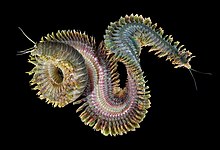Alitta virens
| Alitta virens | |
|---|---|

| |
| Scientific classification | |
| Kingdom: | |
| Phylum: | |
| Class: | |
| Subclass: | |
| Order: | |
| Family: | |
| Genus: | |
| Species: | A. virens
|
| Binomial name | |
| Alitta virens | |
| Synonyms[1] | |
| |
Alitta virens (common names include sandworm and king ragworm; older scientific names including Nereis virens are still frequently used) is an annelid worm that burrows in wet sand and mud. It is classified as a polychaete in the family Nereididae.[1]
Sandworms make up a large part of the live sea-bait industry. To fulfill the needs of this industry, some sandworms are commercially grown.[2] "Sandworming", or the harvesting of sandworms from mudflats, employs over 1,000 people in Maine. As of 2006[update], the population of sandworms had diminished greatly over the preceding few years due in large part to overharvesting before the worms are able to reproduce by spawning. [citation needed]
Sandworms eat seaweed and microorganisms. They have many distinctive traits, including
- often reaching great lengths, sometimes exceeding four feet
- numerous, highly vascularized parapodia along both sides of their bodies
- blue heads with two large pincer teeth which are capable of biting humans[3]
The parapodia function both as external gills (the animal's primary respiratory surfaces), and as means of locomotion (appearing much like short legs).[citation needed]
Gallery
References
- ^ a b c Kristian Fauchald & Chris Glasby (2009). Kristian Fauchald (ed.). "Alitta virens (M. Sars, 1835)". World Polychaeta database. World Register of Marine Species. Retrieved January 19, 2010.
* indicates a heterotypic synonym - ^ De kweek van zagers op landbouwbedrijven in Zeeland
- ^ "King Ragworm". BritishSeaFishing.co.uk. Retrieved 24 January 2014.






